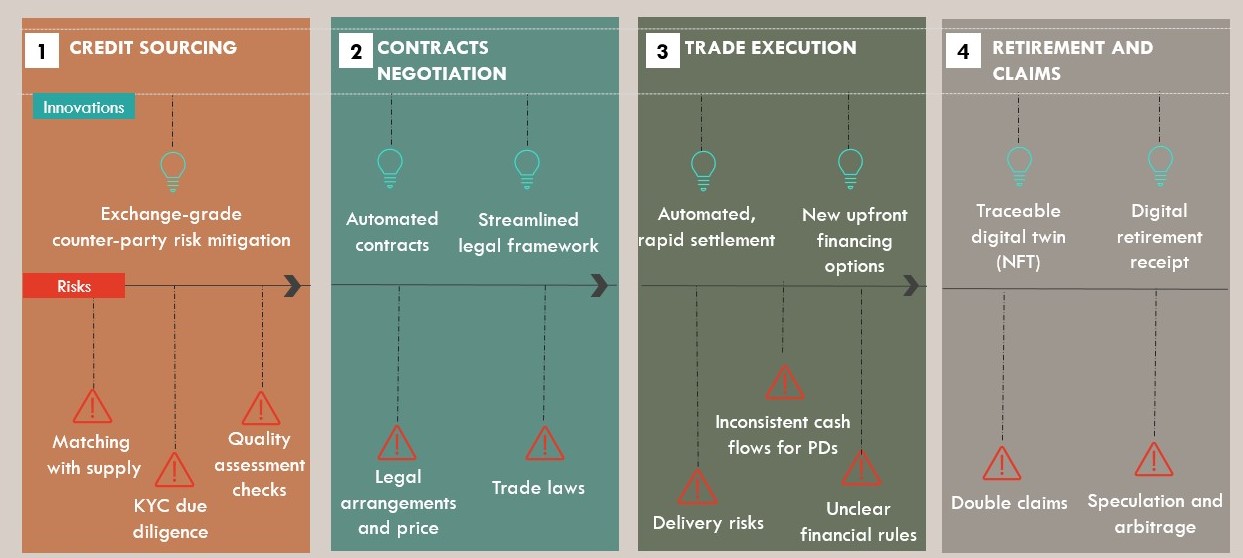
A Path through Carbon Markets Turmoil
For voluntary carbon markets, the best way ahead is to strengthen the integrity of data and processes. Here’s how.
This summer’s headlines — from record-breaking heat waves in Phoenix and Baghdad, to hot tub-esque ocean temperatures off the Florida coast, and devastating wildfires across Maui and Canada — are an urgent call for aggressive climate action that can rapidly reduce 420 gigatons of greenhouse gas emissions or remove 10–13 gigatons of emissions that have already been released by 2050.
As a complementary tool to direct decarbonization, the voluntary carbon market (VCM) — a market mechanism that enables private parties to buy, sell, and invest in carbon credits tied to avoided, reduced, or removed greenhouse gas (GHG) emissions — has the potential to align incentives, unlock critical project financing, and build the institutions required for climate stabilization.
Recently, the VCM has emerged as the go-to mechanism for companies looking to meet their 2030 net-zero targets, for countries searching for a financially viable pathway to climate-aligned growth, and for early-stage climate technology companies seeking a path to commercialization. In 2022, the VCM conducted roughly $2 billion in trades. In 2023, VCM-related headlines focused on the market’s struggles to develop and deliver accurate and reliable carbon credits.
Truth is, the VCM is in transition. Rapid growth is colliding with existing institutions and burdensome processes that were not designed to handle such rapid demand and technological innovation. The “Voluntary Carbon Market Landscape Guide,” recently released by RMI and Climate Collective, unpacks this transition and lays out concrete steps that, if implemented and scaled, will yield a dynamic VCM capable of supporting global decarbonization.
How We Got Here – An Overview of How the VCM and Current Challenges Evolved.
The VCM emerged in the late 1990s in response to the tightly negotiated Kyoto Protocol and has endured as the more informal and accessible mechanism for countries to “trade” carbon credits. Over time, a range of entities have stepped in to grow the market: to pilot new methodologies, build ratings agencies, deploy new technologies, verify credit performance, or create marketplaces. As a result, VCM activity is largely enforced through norms and by a loosely connected set of market actors who are struggling to define, measure, verify, and value carbon credits in an efficient, transparent, and standardized manner.
Strengthening Two Key Pillars of the VCM: Data and Process Integrity
The VCM must be able to accurately, transparently, and reliably value carbon credits based on their credit quality (i.e., environmental and social performance). Credit quality comes from the integrity of both the underlying emissions and co-benefit data (i.e., data integrity) and the process of developing, vetting, purchasing, and claiming the credits (i.e., process integrity) (see Exhibit 1). Data and process integrity are interconnected. A flawless process cannot compensate for fundamental data flaws. If a credit has near-perfect data, but the process is difficult to navigate, buyers will struggle to find — and accurately value — their desired credits. The VCM’s current struggles are the aggregated results of — and interactions between — the flaws, strengths, and gaps of data and process integrity.
Exhibit 1: Data Integrity and Process Integrity
Four Key Unlocks to Improve Data Integrity Throughout the VCM
The path to improving data integrity lies in reducing the subjectivity of credit-related data and improving its objectivity across four areas (see Exhibit 2):
Exhibit 2: Anatomy of a Carbon Credit — Objective and Subjective Data
- Measurement uncertainty. All carbon credits face the same performance challenge: how to estimate, measure, and verify their emissions impact, which is premised on altering future behavior. Some aspects of credit performance are inherently uncertain, but emerging digital and satellite technologies can play a critical role in improving the objectivity of measurement data and reducing the subjectivity of a performance assessment. VCM participants must expand the use of such technologies.
- Subjective interpretation of quality. As the market has evolved and grown organically, it is increasingly home to divergent opinions and a lack of consensus on which standards, data metrics, or certifications indicate “high-quality credits.” Greater transparency and reduced measurement uncertainty will help alleviate the subjective nature of credit quality.
- Lack of transparency on credit pricing or market data. All too often, reliable and detailed information about the prices paid for credits or market transactions remains hidden from public view, indicating that market fragmentation is incentivizing entities to profit from market-wide information asymmetry and uncertainty. This lack of transparency erodes efforts to conduct accurate or reliable price discovery based on a credit’s climate performance.
- Lack of definitive metrics for a credit’s equity and co-benefits information. The VCM was designed to channel revenue to the landowners and communities who are protecting vital carbon sinks or protecting biodiversity outcomes. In practice, it is extremely difficult to assess co-benefits because most indicators are subjective and context specific. Some innovations, like ecosystem DNA mapping, are helping clarify appropriate metrics, but improvements in designing projects in conjunction with local communities, revenue sharing practices, and data collection are also needed to establish uniform social impact metrics.
Tech Advances are Reducing Transactional Risks for Buyers
Today’s VCM buyers must navigate transaction processes that are riddled with uncertainty and risks; market-wide disagreement on “high-quality” prices are not proxies for quality; and an ecosystem of intermediaries that profit from widespread information asymmetry.
Fortunately, the rapidly evolving capabilities of digital and web3 technologies are effective at streamlining transaction processes. For example, decentralized trading platforms can transparently store large volumes of information about a credit’s history and climate performance. New digital and web3 service innovations are improving the accessibility and traceability of credits, streamlining operations and contracting needs, reducing transaction costs, and providing risk mitigation services throughout the transaction process (see Exhibit 3).
Exhibit 3: Digital and Web-3 Innovations across the Transaction Process
The Blueprint for a Dynamic, High-Performing VCM
To build a robust and effective VCM, stakeholders need to strengthen four levers on the supply and demand sides of the market that strengthen data and process integrity:
- Both sides need to reach consensus on credit quality. The supply side needs to focus on defining data quality thresholds based on available technological capabilities and measurement limitations. On the demand side, consistency in corporate guidance and acceptable use help clarify definitions of high-quality credits.
- Certification bodies need to promptly integrate technological advancements, especially remote sensing and web3 technologies, into their data value chains. Remote sensing, web3 technologies, machine learning, and artificial intelligence are showing the most promise to add value in how data is collected, stored, and contextualized.
- Certifiers need to ensure that methodology creation, verification, and validation processes adhere to best practices for expert review and organizational independence.
- The VCM needs to converge around, and scale, a governance model that transparently surfaces the market’s inherent limitations and complexities. This requires a market- and climate-aligned resolution, and a commitment to continually iterate on and integrate improvements in data and process integrity.
The VCM is in a critical stage of evolution and must resolve its structural barriers around data and process integrity before it can fulfill its potential as a critical mechanism for climate finance. The continued integration of digital tools with complementary market levers will strengthen data and process integrity, thus driving consensus on credit quality. Once constructed, these building blocks can catapult the VCM to reach its full potential to deliver climate solutions at scale.
Read the complete Landscape Guide here. To discuss the guide’s insights, contact Caitlin Smith, Manager of the Carbon Markets Initiative at Caitlin.Smith@rmi.org.